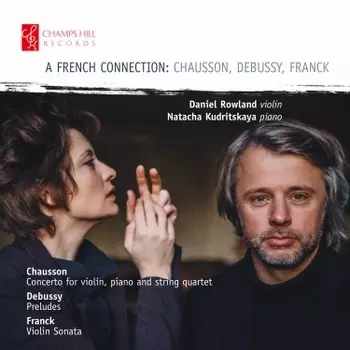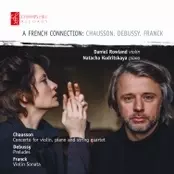A French Connection: Chausson, Debussy, Franck
CHRCD157
- About
Daniel Rowland and Natacha Kudritskaya present two gorgeously romantic pieces in their second recording for Champs Hill: the Franck sonata, a perennial favourite, and the all too rarely heard Chausson concerto for violin, piano and string quartet. This album also features the world premiere recordings of beautiful arrangements of three Debussy preludes by Craig White.
Daniel and Natacha’s previous recording of the Enescu Sonatas for Champs Hill (CHRCD120) was released in 2016 to critical acclaim:
"Daniel Rowland and Natacha Kudritskaya prove to be the perfect partnership and give an exquisite performance of music by Enescu ... Highly recommended." – BBC Music Magazine
"Rowland has a powerful, glamorous tone, gleaming down at the top and throaty and rugged down at the bottom, and Natacha Kudritskaya matches him every bar of the way for passion, fantasy and precision." – Gramophone
- Sleeve Notes
Between 1871 and the beginning of the First World War, Paris became the nexus point for a dazzling array of artistic endeavour, from fashion and cuisine to painting and music. This golden age of peace and prosperity inspired music of exquisite charm, melodic flair, and insatiable joie de vivre, which later became known as the Belle Époque. French composers during this period tended to fall into one of two distinct camps – those determined to establish an independent French school, free of Italian and (most especially) German influence; and those who, having fallen under the spell of Wagner’s epic melodramas, radiated a heady, sensual allure, scented strongly by intense chromatic harmonies.
Ernest Chausson belonged firmly to the latter group, although he was a comparatively late starter – having quit the legal profession, he was 24 before embarking on his advanced music studies under Jules Massenet and César Franck (whose violin sonata closes this disc). The fact that he left behind so tantalisingly few major works was the tragic consequence of a fatal accident, when he lost control of his bicycle on a steep hill and smashed into a wall with such force that he was killed outright.
Chausson was occasionally afflicted by periods of depression, which tended to stifle his creative urge and in part explains why it took him two years (on and off) to complete his concerto-sextet, scored for the unique combination of piano, violin and string quartet. Dedicated to the great Belgian violinist and composer Eugène Ysaÿe, the concerto (as the title implies) focuses on the piano and solo violin as the music’s principle protagonists – this is especially apparent in the ripely expressive opening movement. Yet there is little sign of virtuosity for its own sake, nor of the ‘accompanying’ string quartet being relegated merely to the background. Following the dance-like strains of a Sicilienne, which composer Vincent d’Indy memorably described as ‘the gardens where bloom the charming fancies of Gabriel Fauré’, the Grave slow movement arrestingly offsets a sense of brooding melancholy against lighter moments of poignant reflection. The rondo- style finale brings the work full circle with subtle thematic references to previous movements gradually building up a head of steam for the final emphatic peroration.
Debussy was music’s gentle revolutionary. He approached everything by stealth, cocooning his audiences in a sensual web of textures and sonorities that appeared to suspend time and place. ‘Everything with me is instinctive and unreasonable,’ he once said. ‘I have no experience at all – only instinct.’ When challenged by one of his professors at the Paris Conservatory as to what rule he followed when failing to resolve harmonic dissonances, he replied disarmingly, ‘Mon plaisir!’ For Debussy, music was not something cast in a fixed form, obeying centuries-old concepts of structural counterpoint, but living, organic tissue, growing naturally out of an infinitely malleable variety of rhythms, harmonies and colours.
Although Debussy did not particularly like the comparison, his later music was perceived as sharing certain characteristics with the Impressionist painters Monet (especially), Sisley, Renoir, Cézanne, Manet and Pissarro. Such comparisons are by their very nature tenuous, yet there are indeed striking correspondences between the Impressionists’ tendency towards softening structural outlines and absorbed fascination with the play of light and colour, and the intoxicating musical brushwork of Debussy’s Préludes.
In a letter to his publisher Durand, Debussy wrote in 1907: ‘I am increasingly convinced that music is not, in essence, a thing which can be cast into a traditional and fixed form. It is made up of colours and rhythms.’ This is the key that unlocks the door to his two books of Préludes (originally for solo piano), in which all expressive inessentials have been pared away and discarded. Each book is a veritable catalogue of novel effects and ingenious textural interplay. One interesting touch is Debussy’s insistence that the individual titles be given at the end of each piece, so that the performer might be able to form his own impressions before discovering the true source of Debussy’s inspiration. The title Canope refers to the Canopic jars into which ancient Egyptians used to place the digestive organs of the deceased to accompany them on their journey to the afterlife. Amongst Debussy’s most prized possessions was a pair of Canopic jars which he displayed proudly on his mantelpiece at home. The first prelude of Book 2 to be completed, Bruyères, transports us to the moors of the Scottish Highlands, where one can only stare in wonder at the breathtaking scenery and inhale the gentle perfume of the heather in bloom. La Puerta del Vino (‘Wine Gate’) takes its name from a 13th-century gateway in the Alhambra Palace in Granada, as depicted on a postcard sent to him by his friend and fellow composer, Manuel de Falla.
If Debussy created soundworlds with their own unique harmonic and instrumental flavouring, César Franck’s instinct for colour was honed initially in the organ loft and later (like Chausson) as the result of falling under the spell of the New German School, spearheaded by Liszt and Wagner. Whereas Debussy and Chausson tended in general towards descriptive titles, Franck believed fervently in the supremacy of the chorale, symphony and sonata.
A late developer, Franck was in his sixties before discovering his true creative voice. Until then, composing played second fiddle to his principal vocation as one of Europe’s leading organists and experts in organ construction. Starting out as a piano prodigy, he shunned the bright lights of a potential virtuoso career for the more parochial life of a church musician, becoming organist at St Clotilde, Paris, in 1858.
When, four years later, Franck produced a set of six organ pieces that won Liszt’s enthusiastic approval, he felt tempted to make the break as a full-time composer. Yet, by now, the 40-year-old musician was so deeply entrenched in French cultural life as both organist and pedagogue that such a dramatic change seemed unimaginable. When in 1872 he was appointed professor of organ at the Paris Conservatory, it appeared he might become embroiled in the world of academia. However, after helping (the previous year) to set up the Société Nationale de Musique, created specifically to promote outstanding French instrumental and orchestral music, Franck became convinced that this was where his future lay.
Adapting Liszt’s innovative cyclic techniques, whereby musical ideas recur in the same work in a variety of contexts, Franck forged a new creative style which during the 1880s erupted in a series of unequivocal masterworks, including the D minor Symphony; Symphonic Variations for piano and orchestra; Prélude, Choral et Fugue and Prélude, Aria et Final for solo piano; an epic String Quartet; and the A major Violin Sonata.
The sonata was inspired originally by the marriage of fellow-Belgian and celebrated virtuoso violinist Eugène Ysaÿe to Louise Bordeau. Cast in four movements, it is a work of spectacular contrasts, opening with a sublimely contented Allegro ben moderato, before riding out a stormy Allegro and emotionally intense Recitativo (both musical metaphors for life’s slings and arrows), resolving all strife in an exultant Allegro finale of heartfelt radiance. It was composed ‘con amore’, according to Ysaÿe, who gave the sonata’s premiere to his assembled wedding guests, despite a lighting failure which meant he was forced to perform most of it in the near-darkness from memory.
Julian Haylock
- Press Reviews
- Delivery & Returns
If you order an electronic download, your download will appear within your ‘My Account’ area when you log in to the Champs Hill Records website.
If you order a physical CD, this will be dispatched to you within 2-5 days by Royal Mail First Class delivery, free worldwide.
(We are happy to accept returns of physical CDs, if the product is returned as delivered within 14 days).
If you have any questions about delivery or would like to notify us of a return, please get in touch with us here.

